If you like, you can leave a line like this overnight so that breakfast will be waiting first thing in the morning.
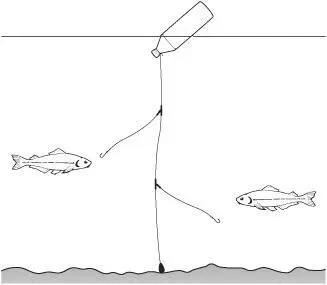
For live bait you can use anything that wriggles, but it needs to look attractive. For fake bait try feathers, small bits of cloth, or even a fish shape whittled out of wood. Keep trying until you find something that works.
If using an improvised hook and line is beyond you, there are all sorts of traps you can invent to catch fish, provided you have a little imagination and a lot of time. Here are some examples of fish traps where the bait inside is accessible by a narrow funnel. The fish can squeeze in but they will find it much more difficult to get out again.
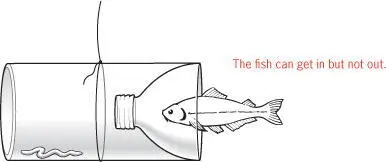
If you are dealing with shallow fertile water, you could also try spear-fishing. Make sure your shadow is not over the potential catch or you will never succeed.
Warning:You can shoot fish with a gun, but never do so with the gun barrel in the water. It will explode, causing the bullet to fire backwards and might kill you.
And another warning:Don’t eat fish you find floating on top of the water – you are likely to explode with hideous food poisoning or worse.
How to gut a fish
Any fish over 5 cm long will need preparation before eating. Cut its throat and let it bleed until it stops. Then make a cut from the top of the throat to the bottom of itsbelly and pull out everything inside (you can save it to use as bait).
Clean the fish with water. Provided it is fresh, you can eat it raw. If you prefer to cook it, see below.
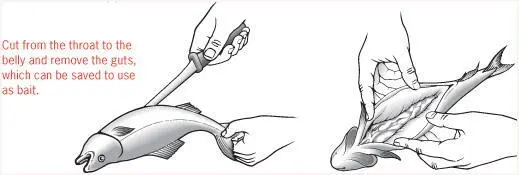
How to cook a fish
Once your fire is going, pop the fish in a pan (if you have one) or on a stick and balance it above the fire with rocks. If you have some foil, you can wrap the fish in that and put it straight on the fire as long as you have a safe way of retrieving it. When fully cooked, fish should lose any jellylike consistency and become opaque. Poke a knife into the centre and check that the flesh is cooked all the way through. Beware of bones when eating it.
How to collect and cook shellfish
Shellfish are found all around the ocean. If you are lucky, you might find a lobster in a rock pool. More likely, you will find clams and mussels clustered around the bottom of rocks under water level. Gathering them is easier and safer after the tide has gone out. And don’t get trapped plucking shellfish when the tide comes back in. Being thrown against rocks by a wave could cause a nasty infected cut if there is any coral element. Oysters are found near river mouths, mainly in shallow waters. They are also found on the seabed, sometimes buried in sand, which makes them much harder to find.
If cooking clams, mussels or oysters, put them in boiling water or a hot pan with the lid on for a minute or so until the shells open and the flesh is opaque. Throw away any that are still shut when you are done with the cooking.
There are a hundred different ways of catching your dinner, be it bird or animal. By far the easiest is shooting. But if you don’t have a gun or much ammunition, use a bow and arrow. Alternatively, use one of the methods below to capture your quarry without weapons.
Note:Even if you start out as a vegetarian, when it comes to survival, your killer instincts will kick into action.
Making a snare
A snare can be as big or small as you need it to be. For example, use rope for a deer, wire for a rabbit, and string for a rat or bird. In your kit you will need:
• Wire
• String or ripped-up lengths of clothes or rope
• Collection of strong and springy wood
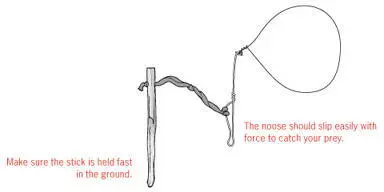
Make a small loop at one end of the wire by twisting it back on itself. Feed the other end of the wire through the loop, then make another small loop at the straight end. Tie a length of string to that final loop.
Hammer a stake of wood into the ground using a shoe or some other heavy object and tie the string to it.
Put the snare in a place where the animal is likely to put a limb or its head, and then drag the snare with it, pulling the lasso tight and trapping it. The snare can be either on the ground or propped up, baited or unbaited (either might work). See illustrations below for ideas.
WHERE AND HOW TO SET TRAPS
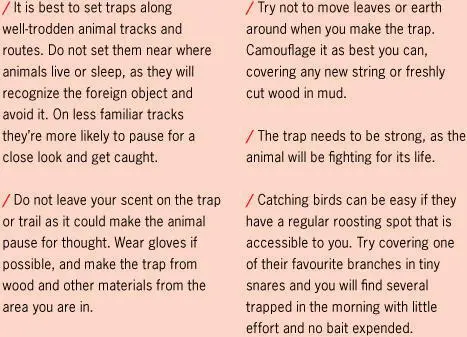
To avoid the animal pulling your stake out of the ground, or chewing itself out, or other game getting hold of it before you do, try using a spring snare. Tie your snare to a sapling, which is being held to the ground by an easily nudged notch in a stake. When the animal runs through, it will be flung up into the air and away from escape.
The more traps you set, the greater your chance of success. Using bait in them may waste a bit of your own food, but it could win you a bigger prize. If the first bait doesn’t work, try another. You will need to be patient. Animals will be suspicious at first about the new addition to their landscape, but they will eventually forget and run into the trap.
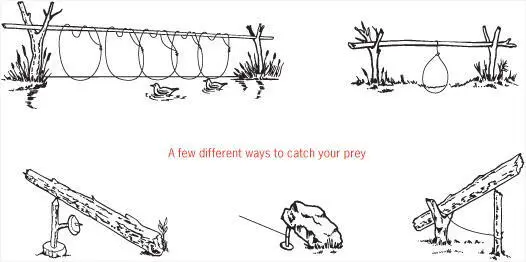
How to make a deadfall trap
If you don’t like the idea of using a snare, where an animal could be trapped for hours before you find it, you could make something more humane, like the deadfall trap overleaf. This way the animal should be killed immediately.
A deadfall trap can be made without any sort of kit at all – just the rocks and materials you have around you. Animal sees bait, eats bait, knocks over stick propping up rock or large log; animal is knocked on head and killed or trapped until you can find it. You will need help setting this up, and be careful not to get yourself trapped in it by setting off the trip wire or twig – whatever method you’re using.
First, cut a square notch in the upright stick and balance two other sticks on it in the shape of a figure ‘4’. You’ll need to make simple V-shaped notches in the balancing sticks to achieve this. Next, carefully balance a flat rock or a ‘cage’ made of twigs against your arrangement of sticks. Once perfected, this trap can be made to any size.
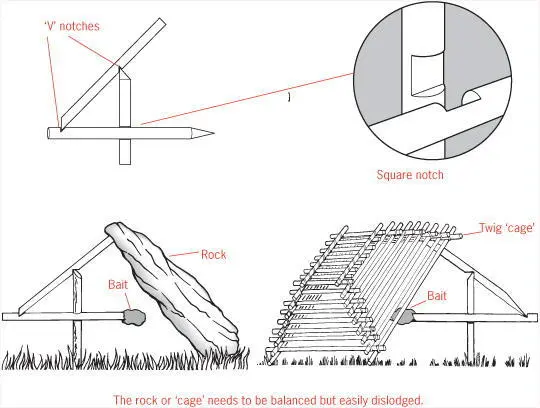
If these arrangements don’t work for you, there are otherways to make deadfall traps, as shown below.

How to catch flying birds
Large birds will go for bait thrown in the air. Tie a stone to the end of a string, wrap some bait around it and throw it up. One of the birds will go for it and then drop to the ground with the weight. Grab the bird while it is still stunned and break its neck by pulling hard.
Читать дальше












![Джонатан Димблби - Barbarossa - How Hitler Lost the War [calibre]](/books/385421/dzhonatan-dimblbi-barbarossa-how-hitler-lost-the-w-thumb.webp)







